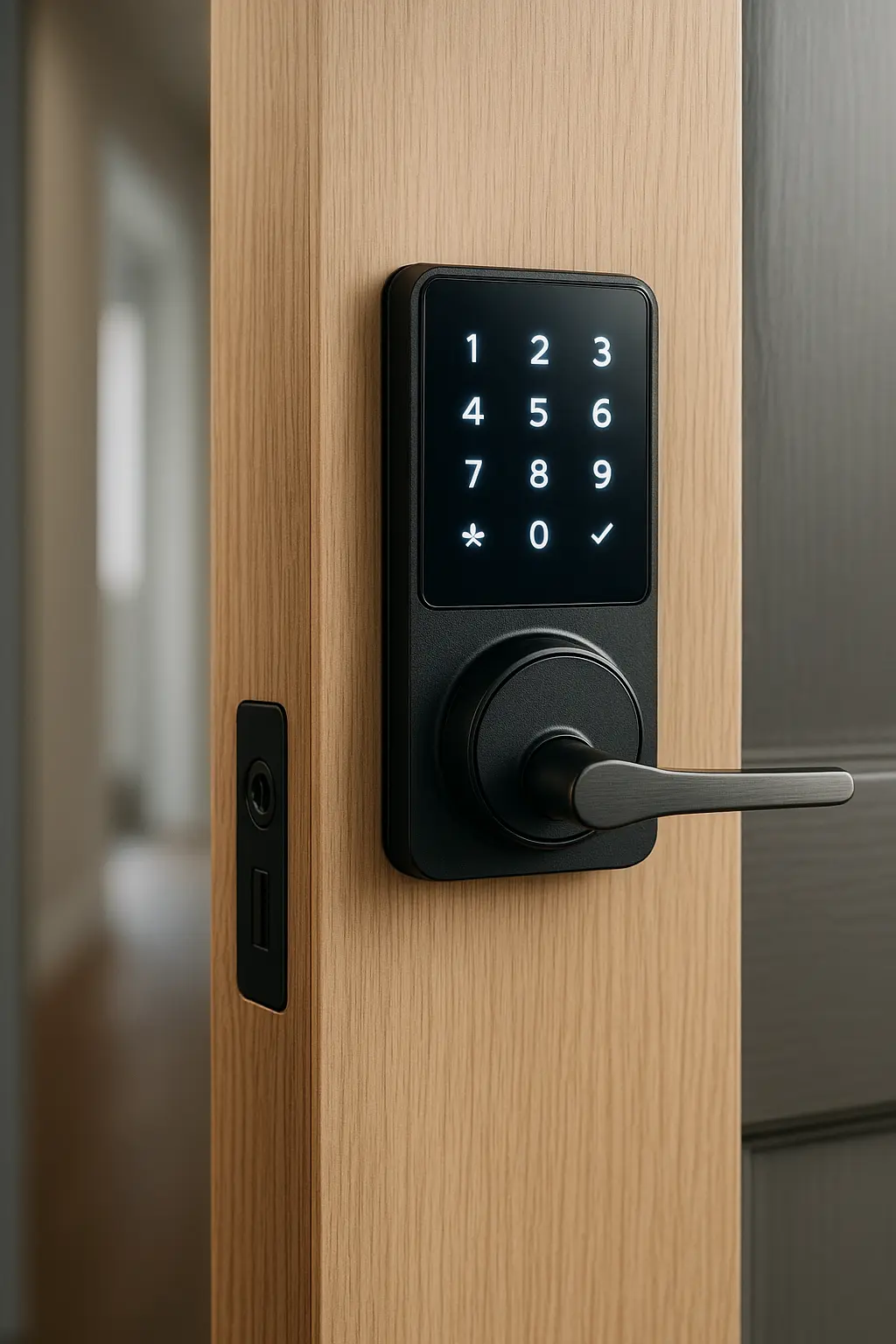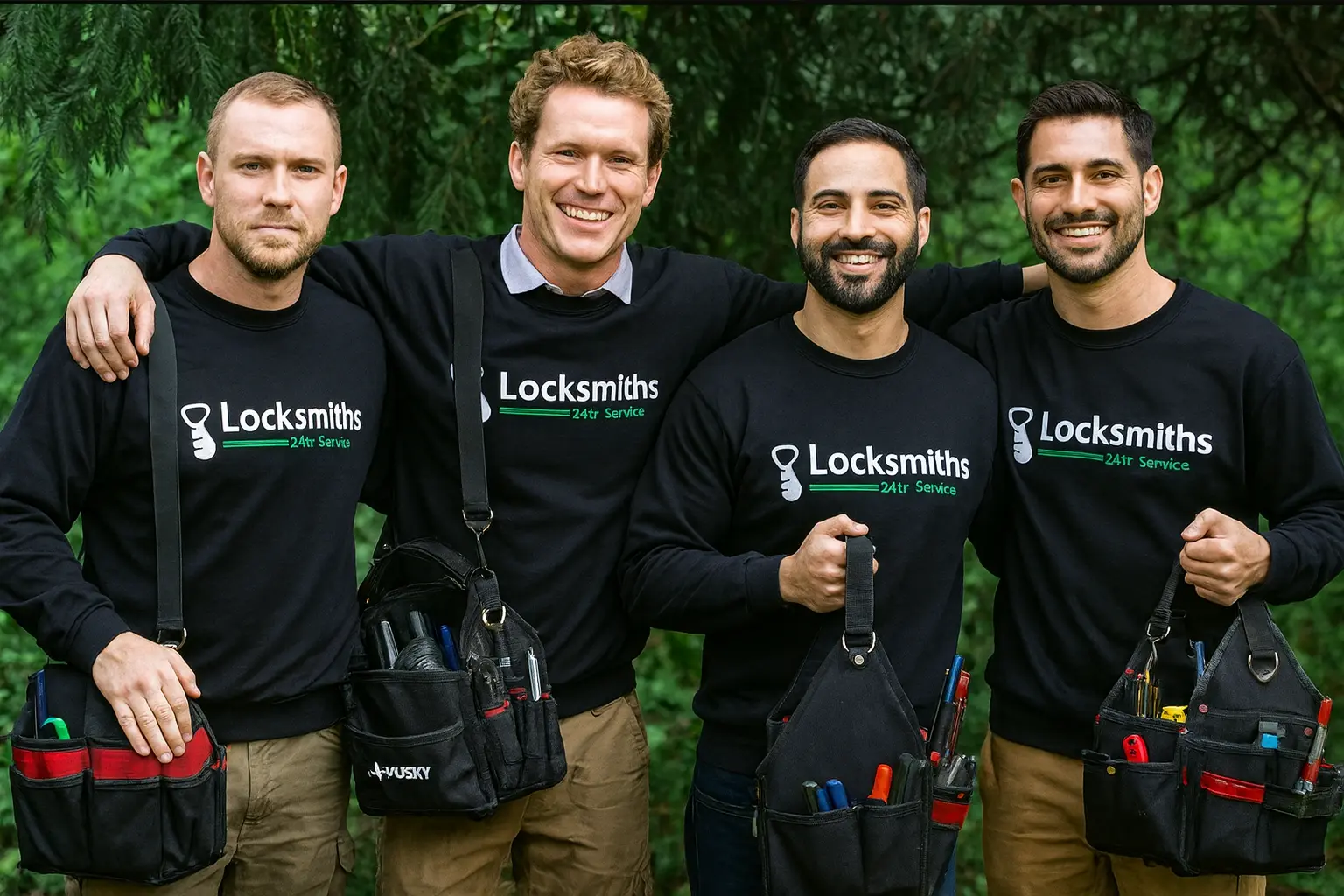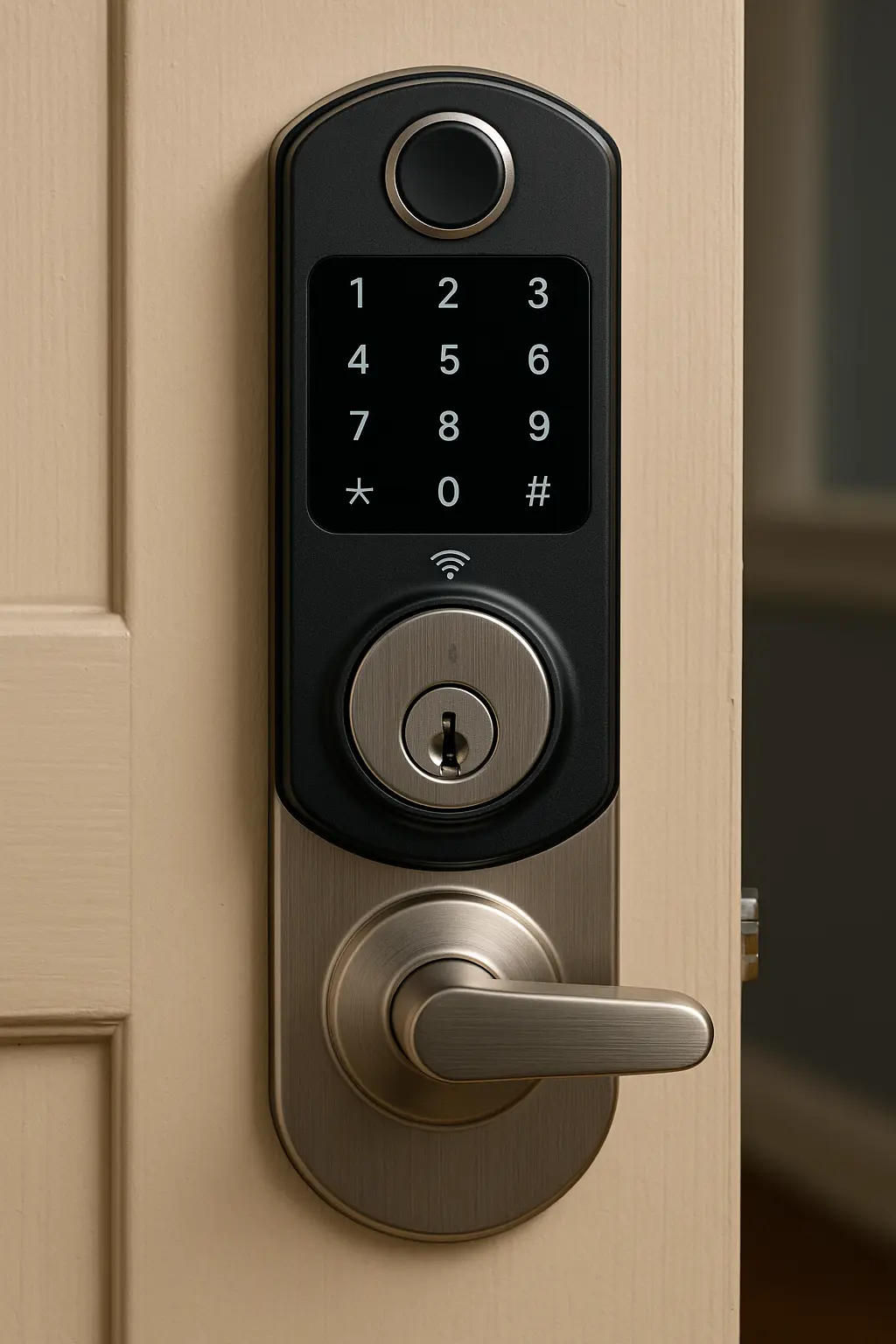Opening Methods
One of the biggest selling points of smart locks is the variety of opening methods they provide. Modern models advertise fingerprint recognition, illuminated numeric keypads, Bluetooth pairing with your smartphone, Wi-Fi connectivity for remote control, voice commands through Alexa, Google Home or Apple Siri, and of course dedicated mobile apps. On paper, this looks like the future of convenience, but after installing and repairing dozens of these devices I can tell you that each method performs very differently in real life situations.
Fingerprint sensors are fast and intuitive when they work properly, and many of my younger clients love the "touch and enter" experience. However, they are not flawless - I have personally seen scanners fail on cold mornings when fingers were too dry, or when hands were wet, greasy, or dusty after outdoor work. Keypads remain one of the most reliable solutions, but they come with human error: people forget codes, children accidentally share them with friends, and in rental properties I've seen tenants recycle the same simple four-digit PIN that neighbors can guess.
Mobile apps bring powerful features such as sending temporary codes to visitors or unlocking the door from across the country, but not everyone in a household is equally comfortable with technology. Elderly family members often struggle with downloading the app, creating accounts, or updating firmware. Bluetooth unlocking feels smooth when your phone battery is strong, but I have watched frustrated homeowners standing outside late at night with 2% battery left, unable to connect. Wi-Fi and cloud-based controls are even more advanced, letting you check lock status from anywhere, but they rely on your home network - if your router crashes or your internet provider goes down, the "smart" lock becomes an obstacle instead of a convenience.
From my field experience, the most practical smart lock systems are those that combine at least two different entry methods and still provide a physical key backup. A fingerprint plus keypad lock, or an app plus Bluetooth lock, gives users flexibility when one method fails. And no matter how advanced the technology, I always recommend keeping a traditional key somewhere safe. At the end of the day, technology can make life easier, but a well-designed backup is what keeps you from being locked out when things go wrong.
Security
Whenever I talk about smart locks with clients, the very first question is always the same: "Are they secure?" And that is exactly the right question to ask. No matter how many apps, sensors, or Wi-Fi features a lock comes with, if it can be pried open with a screwdriver or kicked in within thirty seconds, then all the technology means nothing. I have personally tested budget smart locks that looked sleek and futuristic but were built with thin metal shells. In practice, burglars could bypass them faster than a traditional deadbolt from the hardware store. Looks can be deceiving, and in home security, appearance should never replace real protection.
The higher-end smart locks, on the other hand, combine modern electronics with strong physical engineering. Premium models are built with reinforced steel housings, hardened bolts, and advanced encryption protocols. Many include rolling codes, tamper detection alarms, and AES-128 or AES-256 encryption - the same level of digital security used in online banking. This makes it extremely difficult for hackers to intercept wireless signals or duplicate virtual keys. Some even have built-in accelerometers that detect drilling or forced entry attempts and send alerts directly to the homeowner's phone.
But let me be absolutely clear: digital security cannot replace mechanical strength. I have seen customers rely only on the app, forgetting that at the end of the day the lock is still a piece of hardware exposed to the outside world. A well-designed smart lock should be able to withstand both digital attacks and brute-force physical attempts. That means reinforced bolts, solid strike plates, and certifications that prove the lock has been tested under real break-in conditions.
When I advise homeowners, I always tell them to look for ANSI Grade 1 or BHMA A156.36 certification. These standards ensure the lock has passed rigorous forced-entry resistance tests. I also recommend asking a critical question: "Does this lock still work if the internet goes down?" A truly secure system should operate offline, allowing you to unlock your door without relying on Wi-Fi or a cloud server. Otherwise, you are trading real safety for digital convenience, and that can backfire at the worst possible time.
The bottom line from my field experience is simple: the best smart locks are the ones that blend advanced encryption, reliable authentication methods, and old-fashioned mechanical toughness. That balance is what keeps your home secure against both hackers and burglars. As a locksmith, I would never recommend a model that looks futuristic but lacks the raw physical strength of a high-quality deadbolt. In home security, technology should enhance protection - never replace it.
Ease of Use
Usability is often underestimated until you see your parents or kids trying to operate the system. I remember one installation where a teenager loved opening the door with his Apple Watch, while the grandmother in the same house could never remember how to switch the lock to guest mode. A good smart lock must be intuitive. The mobile app should be simple, not overloaded with unnecessary menus. Adding or removing users should take seconds, not minutes of confusing setup. Battery replacement should be obvious - no hidden screws or special tools required. As a locksmith, I judge a lock by whether a new user can understand it without a manual. Some brands really get this right, others make me feel like I am troubleshooting a computer instead of a door.
Reliability and Maintenance
In my experience as a locksmith, reliability is the factor that separates good smart locks from the ones that end up being expensive headaches. I cannot count the number of emergency calls I have received from homeowners who suddenly found themselves locked out because the batteries in their smart lock died without warning. The better brands now include proactive battery monitoring and send push notifications through the app weeks before power runs out. That simple alert gives you enough time to replace batteries at your convenience. The cheaper models, however, often shut down without any signal, leaving families stranded on their own doorstep in the middle of the night.
Weather conditions play a massive role in maintenance as well. Cold winters are notorious for draining batteries faster than expected. Standard alkaline batteries lose capacity quickly when temperatures drop, while lithium batteries perform far better in freezing conditions. After installing dozens of units in northern climates, I now always recommend lithium upgrades, especially for households that cannot afford to gamble on battery life. I have also seen cases where humidity or rain exposure damaged the electronics of low-cost locks, making them unreliable after only one season outdoors.
Another recurring problem is Wi-Fi dependence. Many modern locks rely heavily on cloud connectivity for unlocking, app synchronization, and status updates. While that seems convenient, it also introduces a major point of failure. I have personally witnessed entire families locked out during internet outages or router crashes, unable to open their own doors until I arrived with tools to bypass the system. A rule I repeat to every client is simple: never buy a smart lock that cannot operate offline. Your front door should never depend entirely on your internet service provider.
Reliability also extends to the durability of moving parts. Motors, gears, and electronic sensors inside smart locks wear out over time. I have seen cheaply made units fail within a year, while higher quality locks continue functioning smoothly after five or six years of heavy daily use. Regular maintenance, such as lightly lubricating the deadbolt, checking alignment between the lock and the strike plate, and keeping firmware updated, can significantly extend a smart lock's lifespan. Skipping these simple steps often leads to premature failure and costly replacements.
At the end of the day, smart features like Wi-Fi access, mobile apps, or voice commands are valuable only if the lock itself remains dependable. Standing outside at midnight in the rain because your batteries drained or your Wi-Fi failed is not just inconvenient - it is unsafe. My professional advice is to prioritize models that combine smart convenience with mechanical reliability, offer offline functionality, and give you clear, early warnings for maintenance. In security, reliability is not optional; it is the foundation that makes all the technology worthwhile.
"I once had a call from a family who returned from vacation only to find their smart lock completely dead because of drained batteries. They had no backup key and no neighbors with access. It took me almost an hour to carefully bypass the system without damaging the door. Since then, I always tell clients: never ignore battery alerts, and always keep a physical backup key available. Technology is great, but reliability is what keeps you safe."

Smart Home Integration
Many buyers want a lock that works with their smart home ecosystem. Some locks integrate seamlessly with Alexa, Google Home, or Apple HomeKit, letting you lock or unlock doors with a voice command or automate routines. I have set up systems where the lights turn on and the thermostat adjusts the moment the door unlocks - clients love that. But other locks come with proprietary apps that refuse to play nicely with anything else. That is a major limitation if you want a unified system. If you are already invested in a smart home platform, make sure the lock supports it natively. Otherwise, you may end up with another isolated app that complicates rather than simplifies your life.
Total Cost
Price is more than just the sticker cost on Amazon. A basic smart lock might cost $150 to $200, while premium models reach $300 or more. Installation is another factor: some locks are simple DIY projects, others require professional fitting which adds to the bill. Then there is ongoing maintenance - batteries, firmware updates, and sometimes subscription services for advanced features. I have seen customers spend more fixing or upgrading cheap models than they would have spent buying a solid product upfront. When evaluating cost, always consider the long term. A reliable $250 lock that lasts five years is a better investment than a $120 lock that fails after eighteen months.
Design and Fit
When most people think about smart locks, they immediately focus on technology, features, and security. But one factor that often gets overlooked until it is too late is design and fit. A smart lock is not just a piece of hardware hidden inside your door - it is a visible part of your home that you will look at and interact with every single day. I have been called back to houses not because the lock malfunctioned, but because homeowners hated how it looked on their beautiful entryway. A shiny chrome lock installed on an old rustic wooden door can look awkward and out of place, while a bulky electronic keypad can clash with minimalist architecture.
The good news is that today's market offers far more design options than just the standard metallic finish. You can now find matte black smart locks, brushed steel designs, bronze finishes, satin nickel, and even slim minimalist models that blend seamlessly with modern glass or aluminum doors. Some brands offer interchangeable faceplates, allowing you to change the appearance without replacing the entire lock. As a locksmith, I have installed smart locks in Victorian houses, mid-century suburban homes, and ultra-modern lofts - and in every case, the choice of finish and style made a huge difference in how satisfied the customer felt afterward.
Fit is just as important as looks. Not every smart lock is designed to work with every type of door. I have seen homeowners buy expensive models online, only to discover that they do not fit properly on thicker doors, older mortise locks, or doors with unusual spacing between the handle and the deadbolt. A poor fit can make the lock harder to use, wear down batteries faster, or even compromise security if the bolt doesn't align perfectly with the strike plate. That is why I always advise checking compatibility before purchasing, and when in doubt, consulting a locksmith who can confirm that the lock you want will actually fit your door.
It might sound superficial, but style and design play a major role in overall satisfaction. Homeowners who choose a lock that matches their décor - whether it's rustic, modern, or industrial - report much higher levels of happiness with their purchase. On the other hand, if the lock looks out of place, frustration builds quickly even if the technology works perfectly. Remember, this is not just a gadget - it is part of your home's first impression, something guests notice before they even step inside.
"One client once told me that every time she came home and saw the oversized silver keypad on her elegant wooden front door, it bothered her more than she expected. The lock worked flawlessly, but she eventually asked me to replace it with a slimmer matte black model that blended into the door's design. Only then did she feel truly happy with her choice. Looks may seem secondary, but in practice, they matter as much as functionality."
Real Pros and Cons
The biggest advantage of smart locks is flexibility. You can grant one-time codes to delivery drivers, give temporary access to houseguests, or track who enters and exits your property. Parents love being able to check that their kids made it home from school. Businesses appreciate audit trails for employees. But the disadvantages are just as real: dead batteries, app malfunctions, Wi-Fi outages, or forgotten backup keys. I have had frantic calls from clients who could not enter their homes because they never kept the physical key handy. Smart locks are powerful tools, but they require responsible use. My advice is simple - enjoy the technology, but always keep a spare key and make sure every household member knows how to use it.
"After years of installing and repairing smart locks, my conclusion is clear: they are not magic solutions, but when chosen wisely, they make daily life easier, safer, and more connected. Pick one that balances technology with reliability, and it will serve you well."
Final Thoughts
Smart locks are part of the future of home security, but they are already here in thousands of homes. They offer convenience, control, and integration, but only if you choose the right model for your needs. As a locksmith, I encourage every homeowner to think carefully about security, usability, cost, and backup options. A smart lock is not just a gadget - it is the guardian of your front door. Treat the decision with the same seriousness as any investment in your family's safety.

